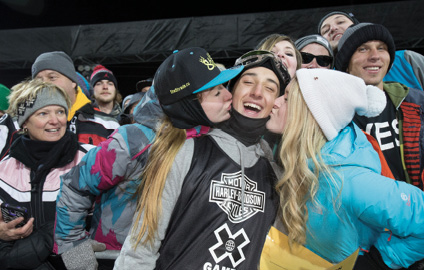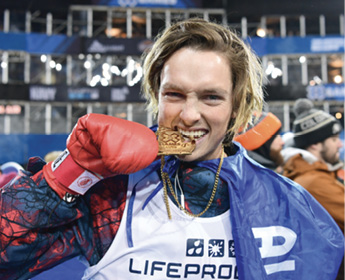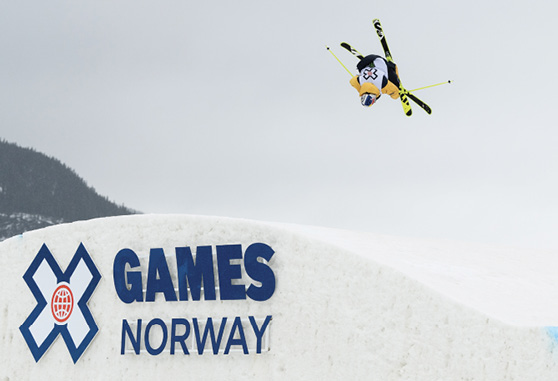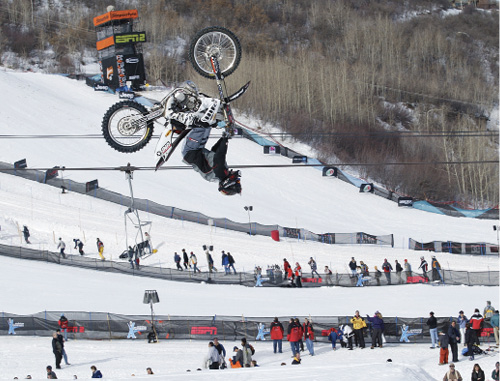SKIING HISTORY
Editor Greg Ditrinco
Consulting Editor Seth Masia
Art Director Edna Baker
Editorial Board
Seth Masia, Chairman
John Allen, Andy Bigford, John Caldwell, Jeremy Davis, Kirby Gilbert, Paul Hooge, Jeff Leich, Bob Soden, Ingrid Wicken
Founding Editors
Morten Lund, Glenn Parkinson
To preserve skiing history and to increase awareness of the sport’s heritage
ISHA Founder
Mason Beekley, 1927–2001
ISHA Board of Directors
John Fry (1930-2020), Chairman
Seth Masia, President
Wini Jones, Vice President
Jeff Blumenfeld, Vice President
John McMurtry, Vice President
Chan Morgan, Treasurer
Einar Sunde, Secretary
Richard Allen, Skip Beitzel, Michael Calderone, Christin Cooper, Art Currier, Dick Cutler, Chris Diamond, David Ingemie, Joe Jay Jalbert, Rick Moulton, Wilbur Rice, Charles Sanders, Bob Soden (Canada)
Presidential Circle
Christin Cooper, Billy Kidd, Jean-Claude Killy, Bode Miller, Doug Pfeiffer, Penny Pitou, Nancy Greene Raine
Business & Events Manager
Kathe Dillmann
P.O. Box 1064
Manchester Center VT 05255
(802) 362-1667
kathe@skiinghistory.org
Membership Services
Laurie Glover
(802) 375-1105
laurie@skiinghistory.org
Corporate Sponsorships
Peter Kirkpatrick
(541) 944-3095
peterk10950@gmail.com
Bimonthly journal and official publication of the International Skiing History Association (ISHA)
Partners: U.S. Ski and Snowboard Hall of Fame | Canadian Ski Museum and Hall of Fame
Alf Engen Ski Museum | North American Snowsports Journalists Association | Swiss Academic Ski Club
Skiing History (USPS No. 16-201, ISSN: 23293659) is published bimonthly by the International Skiing History Association, P.O. Box 1064, Manchester Center, VT 05255.
Periodicals postage paid at Manchester Center, VT and at additional mailing offices. Postmaster: Send address changes to ISHA, P.O. Box 1064, Manchester Center, VT 05255
ISHA is a 501(c)(3) public charity. EIN: 06-1347398
Written permission from the editor is required to reproduce, in any manner, the contents of Skiing History, either in full or in part.
History of an X-Rated Phenomenon
Arguably nothing has had a bigger impact on skiing and snowboarding during the past 25 years than the Winter X Games.
Standing at the start of the 2012 Winter X Games SuperPipe in Aspen for his final run of the event, snowboarder Shaun White was the dominant and defending champion in the event and already a certified legend. Just to drive that point home, he made a run that soared 15 to 20 feet above the shiny pipe walls, casually spinning and whirling like some enraptured snow dervish. When it was over, he’d thrown the first-ever frontside double cork 1260 (three full spins with a double horizontal twist) in a pipe and scored the first and only perfect 100 in the event in X Games history.
“I’ve waited for that one hundred for a long time!” said the jubilant 25-year old. He also picked up another gold to add to an overall medal stash of 18 as of this writing. It’s all part of a stellar career that surely has him headed into the US Ski and Snowboard Hall of Fame.
In January of 2020, Mark McMorris tied White’s medal record with a silver at Snowboard Big Air in Aspen, then topped it at the Norway X Games with a gold. Whether this major achievement will help propel him into the Hall of Fame remains to be seen. But that it could, illustrates the status the Winter X Games have attained.
They got there in part by pioneering many firsts in winter sports (first switch triple rodeo, first snowmobile front flip, and so on). Winter X Games 2021 had its own dubious first: It took place in a quarantine bubble in Aspen without the 111,500 live fans who watched in 2020.
Coverage ran live on ESPN and ABC throughout the four-day event, and will rerun almost incessantly across ESPN’s many platforms for the rest of the year. That’s because the games generate some of the network’s biggest ratings outside of professional and college football, basketball and baseball. And Winter X gives skiing and snowboarding their biggest global audience other than the Olympics, reaching up to 215 countries and territories and 400 million households.
This transformative and deeply lucrative franchise arose from brainstorming at ESPN in 1993 aimed at creating a world-championship-level gathering of action—or alternative or extreme (take your pick)—sports. The concept was unveiled at a press conference at the New York Planet Hollywood in 1994. In 1995, 27 events in 9 different categories were held at the first X Games during the last week of July in Rhode Island.
With an enthusiastic response from everyone—the athletes, the hosts, 198,000 spectators and, critically, the high-profile sponsors—ESPN realized they were on to something. Plans began evolving and expanding, an ongoing process today. The network scheduled events annually instead of every two years as originally conceived, and cloned the product.

draw huge crowds, with 111,500 turning out in 2020.
That resulted in the first Winter X Games, at Snow Summit in Big Bear Lake, California, in 1997. The following two years the Games were held in Crested Butte, Colorado, and then moved for two years to Mount Snow, Vermont. Since 2002, the event has been held in Aspen.
The 1997 inaugural lineup consisted of five divergent categories of competitions held over four days: Snowboarding (BoarderCross, Big Air and Slopestyle), Ice Climbing, Snow Mountain Bike Racing, Super Modified Shovel Racing, and a crossover multi-sport event.
For the first time ever, ESPN’s sister channel ABC broadcast an X Games event, and coverage reached nearly 200 countries. Shaun Palmer won both the BoarderCross and the Snow Mountain Bike race for what would be the first two of his six total Winter X medals, all of them gold. Sweden’s Jennie Waara won gold, silver and bronze in three separate snowboard events, still a Winter X record.

programming, with Jumbotrons and A-List
performers for those who watch (or attend)
with no intention of checking out the athletics.
Striking in retrospect is that skiing itself wasn’t even included. The glaringly insane—and not widely followed—shovel race was axed after one year. Mountain bike racing downhill on snow didn’t survive much longer. But the snowboard events flourished. And new skiing comps along the same lines were introduced in 1998 with Freeskiing and Skiboarding (a terrain-park oddity on tiny skis jettisoned in 2001) at the new venue of Crested Butte.
This second Winter X also added snowmobiles. Skiing and snowboarding today form the bulk of the Winter X Games and drive their broadcast popularity. But snowmobiles (and for awhile motocross bikes) have played a prominent role, too, and routinely attract some of the biggest live crowds in Aspen, who come for the noise, danger and NASCAR-style action.
Skiing and snowboarding also had dangerous, head-to-head events. BoarderCross (or Boarder X), featuring multiple riders on a wild course, was in the games from the start for both men and women. SkierCross was soon added, and both are now in the Olympic Games. Part of the thrill is the imminent possibility of disaster. Sure enough, carnage ensued. And after 20 years the events were dropped from Winter X in 2013. Boarder Cross was reintroduced back in 2014, but both are now gone.

Games is media exposure and hero-
building. But a gold medal in 2020
also delivered a tasty $50,000 check.
The first five years saw the introduction of women’s Freeskiing, and Shaun Palmer was the first to win gold three years in a row, doing it in BoarderCross (’97-’99). The SuperPipe replaced the original Halfpipe competition in 2000 when organizers raised the walls from 11.5 feet to 15 (the walls grew to 22 feet in 2009). Todd Richards, Barrett Christy, Ross Powers and Tara Dakides were tough to beat in the early years when frontside and backside 720s (two full spins) won gold in Snowboard Halfpipe and Slopestyle.
In 2002 Aspen Skiing Company officials finally reversed a longtime ban on snowboards on Aspen Mountain and needed a way to publicize their change of attitude. X Games honchos were attracted by Aspen’s fame, and by the opportunity to present all the winter events at one venue: Buttermilk ski area.
Killeen Brettman, head of communications for ASC at the time, said, “When we sensed there was a chance to get the X Games, we decided this would be a bigger bang than anything else we were considering. The fact that a resort of Aspen’s stature was interested in hosting their event was appealing to ESPN in that they felt being accepted here gave their event tremendous credibility.”
Not everyone in Aspen was thrilled, of course. Some feared X Games crowds were just rowdy hip-hoppers with bad attitudes and no money. Even after the games succeeded, familiar questions around town were, “What do people see in all of this? And why do they like it better than the World Cup races?” Even early on, Winter X outdrew Aspen’s World Cup races, live and on TV. Sponsors, naturally, noticed.

Boarder X and Hill Cross were designed to
display both world-class athletic skill and
survival instincts.
When three full rings of the Winter X circus went off simultaneously, either you got it or you didn’t. With skiers arcing high above the walls of the SuperPipe, padded gladiators battling down a full-contact BoarderCross course, snowmobiles flying through the sky in the tear-ass SnoCross races, music pounding and Jumbotrons flashing images of it all to every corner of the premises, it was action-packed snow theater for our short-attention-span times. Not incidentally it also featured great athletes doing crazy and amazing athletic things.
As an index of the event’s importance, the entire U.S. Olympic freestyle snowboarding team showed up in Aspen to compete in the 2002 SuperPipe, just a few weeks before the Winter Olympics in Salt Lake City.
Aspen’s own three-time Winter X gold medalist Gretchen Bleiler boiled it down when she said, “For me the Olympics will always be huge, but the X Games are becoming the modern Olympics because the kids are really into them.”
On the business side, ESPN ramped up world domination plans by launching the X Games Global Championship in May 2003. A team event with both winter and summer sports, it was held simultaneously in Austin, Texas and Whistler Blackcomb, British Columbia. More than 69,000 spectators attended live, Team USA won, and women’s ski SuperPipe was introduced with rising star Sarah Burke taking gold. There hasn’t been a second edition. ESPN found other ways to become an international brand.
By 2010, live annual attendance blew past 80,000. The games were carried across all ABC and ESPN media platforms, including clips on iPod, nightly X Center highlights, and daily mobile content.
In 2004, the first time ESPN and ABC broadcast the games live, they added massive lighting for nighttime, prime time viewing. It helped juice up television viewership over 30 percent from the previous year. And by 2006 viewership hit a record of more than 747,000 households, raising the 2005 numbers by 45 percent. The audience in every form was expanding exponentially.
The juggernaut helped create big stars such as Bleiler, White, Kelly Clark, Travis Rice, Lindsey Jacobellis, Tanner Hall and Sarah Burke. Winter X raised the bar every year on what could be done, expanding the limits of the sports and providing unprecedented opportunities for riders who had few other options at the time.
The Games also became labs for advancements in park and pipe gear, as well as features like twin tips that made their way to the general public. The entire new hard and soft goods industry that had sprung up for boarding got a huge boost as dedicated park and pipe ski lines such as Armada and 4FRNT joined pioneers like Burton and Jones, and crossovers from the surfing and skateboarding worlds like Oakley and Quiksilver, all flourishing in the bright lights of the X Games.

Tignes, France, among other destinations.
A decade later, only Norway still plays host
outside North America. But ESPN has
recently licensed Winter X in Asia for 2021
and beyond
“Winter X has brought sports like skiing and snowboarding into people’s living rooms that probably would never have seen them before,” said Chris Davenport in 2004, when he became an announcer for them. Davenport got a bronze in Skier X at Crested Butte in 1998. “It’s one of my prize possessions, seeing how big the X Games have become,” he said, adding that they’ve “helped mainstream our sports and the athletes that participate, leading to more money from sponsors. Today we see more kids getting into skiing and snowboarding because they have been exposed to them through Winter X.”
Meanwhile, ESPN’s long shot bet on crazy youth looked brilliant. “In 10 years the X Games have become, pound for pound, one of the most valuable enterprises in television sports‚—and a favorite venue for Sony, Gillette and other marketers eager to reach an elusive audience: 12-19-year olds,” wrote Monte Burke in Forbes in February of 2004. It was no secret ESPN targeted generations X and Y, and succeeded. Burke also noted that in four years TV ratings for the winter games increased 88 percent, and that in 2003, 37 million people watched some slice of them.
He further pointed out that the astronomical cost of buying major league sports rights was predicted by Morgan Stanley to cause “billions of dollars in losses for the four major broadcast networks in the next four years.” On the other hand, the X Games, winter and summer, were expected to bring in up to $70 million for 2003 and net $15 million, “though ESPN executives insist the franchise’s overall profit is only $1 million.”
However much they’re cashing in, it’s in large part because they own the games outright, coughing up zero for TV rights, with no risk of losing them to a rival network in a bidding war. Disney, ESPN’s owner, doesn’t break out ESPN’s financial performance, so it’s hard to know how much that network makes, let alone its X Games brand. But the fact that reruns air constantly suggests healthy ad sales.
One important question Burke raised in Forbes was whether athletes are fairly compensated given the amount of money the games generate. Some athletes said no, and made attempts to unionize and launch competing events. But many of the top competitors seemed to agree with Barrett Christy, who made $100,000 annually in endorsements, when she said, “They’re not paying us enough, but I’m where I am because of ESPN.”
For ESPN’s part, President George Bodenheimer said, “No one is holding a gun to anyone’s head to participate.” Then they began adjusting their awards scale.
“When the X Games first started, the total prize money was $186,000,” said ESPN PR director Katie Moses Swope. She then explained that as the games and athletes were progressing, so were the financial rewards. For 2007, gold medal wins were reportedly worth $20,000, and by 2008 were up to $30,000 out of a total purse of a million dollars.
Meanwhile, athletes understood that winning Winter X metal, and the constant drumbeat of media coverage on ESPN, helped them earn name recognition with kids everywhere. The program guide became a Who’s Who of extreme sports.

snowmobile freestyle event in 2013, ESPN
eliminated the “best-trick” format for
motorsports, including motorcycle and
snowmobile competitions.
ESPN introduced disabled sports at Winter X 2007 with a combined men’s and women’s MonoSkier X event, with Tyler Walker taking home the first gold, and Sarah Will, the top female finisher, coming in fourth overall.
In 2010, Winter X went global with an event in Tignes, France. Games followed around the world, but 10 years later only Norway plays host outside North America. Now ESPN has licensed Winter X Games in China and Asia in 2021 and beyond, and is optimistic about further franchising.
In April of 2020 Luis Sanchez followed up on Monte Burke’s story 16 years earlier by doing “some detective work” for a financial website on Disney’s media properties. Sanchez concluded that “ESPN likely generated at least $11.4 billion of revenue last year.”
Assuming total expenses of around $9 billion, “it implies that ESPN generates over $2 billion of annual operating income … and probably a good deal more.”
Given that profits are hard to come by in the major sports league coverage, it isn’t unreasonable to think that the X Games could be earning hundreds of millions or more of that total. Perhaps reflecting these impressive figures, an X Games gold medal in 2020 came with a $50,000 check.
A new generation of stars is rising to the occasion. Former teen sensation Chloe Kim already has seven medals, including five gold, from seven Snowboard SuperPipes starting in 2015. Reigning Snowboard Big Air queen Jamie Anderson takes lots of risks and gets lots of injuries. Also, lots of medals: 16 so far, more than any other female snowboarder in Winter X, ever. And last year skier Gus Kenworthy (five medals and counting) threw the first ever switch triple rodeo 1440 (three backflips with four full rotations) in Slopestyle, as the barrage of high-flying aerials continues. There’s no end in sight.
It’s a fitting metaphor for the Winter X Games, still flying high, unleashing genius and breaking records—a quarter of a century later.
Table of Contents

Corporate Sponsors
ISHA deeply appreciates your generous support!
WORLD CHAMPIONSHIP ($3,000 AND UP)
Gorsuch
Polartec
WORLD CUP ($1,000)
Aspen Skiing Company
BEWI Productions
Bogner
Boyne Resorts
Dale of Norway
Darn Tough Vermont
Dynastar | Lange | Look
Fairbank Group: Bromley, Cranmore, Jiminy Peak
Gordini USA Inc. | Kombi LTD
HEAD Wintersports
Hickory & Tweed Ski Shop
Intuition Sports, Inc.
Mammoth Mountain
Marker-Volkl USA
National Ski Areas Association (NSAA)
Outdoor Retailer
Rossignol
Ski Area Management
Ski Country Sports
Snowsports Merchandising Corporation
Sport Obermeyer
Sports Specialists, Ltd.
Sun Valley Resort
Vintage Ski World
Warren and Laurie Miller
World Cup Supply, Inc.
GOLD ($700)
Race Place | BEAST Tuning Tools
The Ski Company (Rochester, NY)
Thule
SILVER ($500)
Alta Ski Area
Boden Architecture PLLC
Dalbello Sports
Ecosign Mountain Resort Planners
Fera International
Holiday Valley
Hotronic USA, Inc. | Wintersteiger
MasterFit Enterprises
McWhorter Driscoll, LLC
Metropolitan New York Ski Council
New Jersey Ski & Snowboard Council
NILS, Inc.
Russell Mace Vacation Homes
Schoeller Textile USA
Scott Sports
Seirus Innovations
SeniorsSkiing.com
Ski Utah
Swiss Academic Ski Club
Tecnica Group USA
Trapp Family Lodge
Western Winter Sports Reps Association
World Pro Ski Tour


